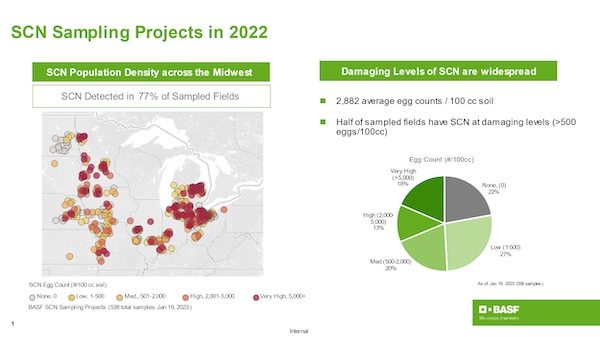By Jeremiah Mullock, BASF Product Manager, Seed Treatment
If growers followed the adage “seeing is believing,” they’d have thrown in the farming towel years ago. There are simply too many diseases and pests lurking beneath the soil for growers to have a wait-and-see attitude. The soybean cyst nematode (SCN) is the most destructive pest soybean growers face today, and once growers recognize the obvious SCN symptoms, it’s too late.This issue is what led to a second-annual SCN Action Month, an awareness campaign from BASF and The SCN Coalition. The month was dedicated to educating growers about the threat of SCN destruction and the importance of testing soil for the elusive pest. Each week, growers were encouraged to learn more about soil sampling and how to effectively manage SCN.
Testing for SCN: Why is it important?
Testing for SCN is vital for growers as damage can be done before your eye can visibly see the impact. Soil tests are typically conducted in the fall when harvest has concluded, and poor yielded areas are at the top of mind. It’s obviously a busy time for growers, but it’s risky to avoid yearly soil tests for SCN. And although fields are typically tested in the fall, in-season spot checks can help indicate if there are nematode feedings in the field. By testing soil and learning your SCN numbers, you can make a proactive plan to manage SCN for upcoming growing seasons. Once detected, the nematodes will always be there to some degree, but you cannot effectively manage a persistent pest like SCN if you’re unaware that it’s present.
The results are in: SCN numbers continue to climb
In 2022, BASF gave out 538 soil test kits and analysis to growers, and the results were eye-opening. Below are a few key takeaways from this year’s SCN Action Month soil sample kits and analysis:
- SCN was present in 77% of the samples (up 4% from the previous year).
- The average egg count across all the samples was 2,882 eggs per 100cc.
- SCN was at damaging levels (>500 eggs/100cc) in half of the samples.
Among those growers who sampled their fields was Dan Ory. Dan is a grower in Earlham, Iowa, and was startled by his results during SCN Action Month. “I had the opportunity to test my soil using one of the free test kits,” Ory said. “I suspected we had nematodes, but I was surprised by how many. It was a revelation that changed how I approach my soybean fields going forward.
Preparing your fields each season: Utilize a seed treatment you can trust Now that you know your numbers, creating a plan each year should be at the top of your list because once a seed is planted in the ground, there is nothing you can do to protect your seed, roots and plants from SCN. With SCN populations becoming resistant to PI 88788, managing nematodes has become more complicated than ever. This has led to higher populations and more hidden yield loss. Growers can implement four simple ways to actively manage SCN on their farms:
- Test fields yearly to know their numbers.
- Rotate resistant varieties.
- Rotate to non-host crops.
- Consider using a seed treatment nematicide.







Post a comment
Report Abusive Comment